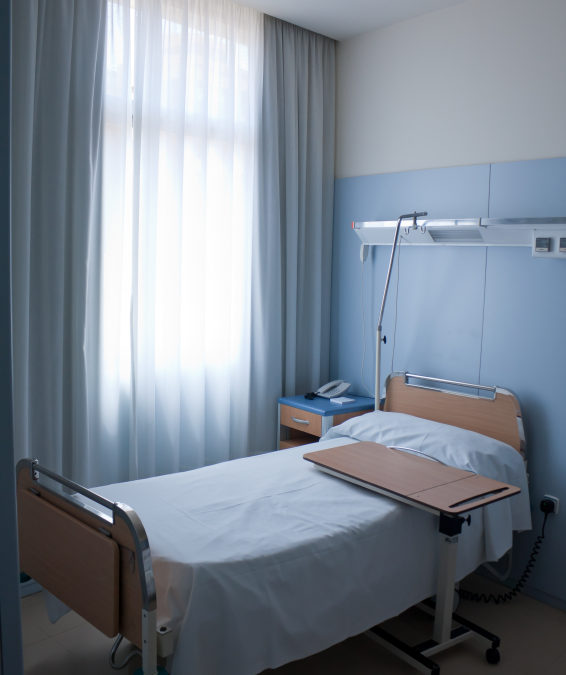There’s a condition that I call “Sinking in Bed Syndrome”, which is one of the biggest epidemics affecting US healthcare facilities (I am actually going to patent that term). And sadly I have only seen it get worse because of COVID-19 restrictions, both in acute healthcare facilities (hospitals) and also sub-acute (rehabilitation). Patients are moving around less and sadly becoming more and more deconditioned. If you have a loved one who has suffered because of this, and have a story to tell, please do get in touch with me. Because I feel very strongly that it’s such a simple thing that most healthcare facilities are pretty terrible at. I am reposting this piece I wrote on the ubiquitous syndrome, from a few years ago, and intend to keep doing so every so often until I see some progress:
——————————————————————————————————————-
There’s a huge problem we have right now affecting our nations’ hospitals. It’s not a disease you’ve ever heard of before, or something that cutting edge research or treatments are going to solve. It’s a seemingly simple issue that has been lacking in every single hospital I’ve ever worked in, whether it be a large academic teaching hospital or a small rural medical center. It’s rarely talked about, but endemic nevertheless. I’m hereby going to assign it a name:
“Sinking in bed syndrome”
What on earth is it you may ask? Well, the scenario goes something like this. A patient, usually elderly, is admitted to hospital with an acute medical illness. During the first few days of treatment, they are basically lying in bed while receiving all their treatments. They get more and more sunk into their bed, becoming weaker and weaker at the same time (even though their actual illness is improving). As they recover, they find it more difficult to get up out of bed and start walking again. The longer they are in bed, the more difficult it will be. Muscles have become tense and joints are stiffer. Because of this deconditioned state, recovery will be prolonged and patients will spend longer getting back to their baseline state.
All hospital-based doctors see this type of scenario unfold on a weekly basis. Sadly, lots of these patients actually report having quite reasonable and independent function prior to their admission. Of course, they have been unwell, and their illness itself will set them back. But having seen how we leave patients “sinking” in their bed for days at a time, I’m of the firm belief that keeping them in this state really sets them back even more.
In short—we just need to get them up much sooner. Unfortunately, it’s not in our systemic culture to do that, and in almost all places I’ve worked—I sometimes need to plead just to get our patients up out of bed to the chair simply to make sure they are not lying down flat all the time. Sometimes sadly, it’s family members who are the ones voicing their concern to me that their loved ones have become weak and need to sit up and walk more. It’s a shame too that many healthcare institutions only think of getting physical therapy involved when discharging from the hospital is imminent—when actually it should be done much sooner.
Only a few decades ago, the culture was to keep patients who were sick in the hospital on complete bed rest for an extraordinarily long amount of time. Patients having heart attacks would be kept in and observed for several weeks. We now know that such a prolonged hospitalization is not only unnecessary, but also very bad for our patients.
So why do we not get our patients up sooner? I believe it’s not a question of laziness or lack of resources. Nurses and nurses’ aides are the most hardworking people I’ve ever encountered, and most nurses are aware that it’s good to get patients up and moving. However, in the haze and hustle of a hospital admission—with intravenous lines, telemetry monitors, strong medications and constant tests—we lose sight of the simple little things that can make an enormous difference. In my experience, patients even just look so much better sitting up in a chair as opposed to lying in the bed!
So here’s what the world of healthcare should really push for: A National Ambulate the Patient Week. This should involve:
- Education for all healthcare professionals about the importance of ambulation. Physicians should be encouraged to write “OUT OF BED TO CHAIR AT LEAST THREE TIMES DAILY” as an order for nearly all hospitalized patients as soon as they can, usually from hospital day 2. With that order should be assumption to “ENCOURAGE AMBULATION”, either with or without assistance depending on the circumstance
- Invest in more physical therapy services and also dedicated PT-aides, also known as “walkers or mobility aides”, to get people up and moving early
- Administrative oversight from charge nurses and unit supervisors to raise a red flag when they see a patient who potentially has “sinking in bed syndrome”
- Posters around hospitals encouraging early ambulation and walks around the hospital floor
- More comfortable chairs! This may sound rudimentary, but a common complaint I hear everywhere is that hospital chairs are very uncomfortable. However much they are purportedly designed for hospitalized patients, just glancing at them and testing them out myself—I’m very skeptical about how comfortable patients can feel sitting in them. I get the same feedback from relatives who test them out. If healthy people don’t feel comfortable in any given place, how on earth do we expect sick people to?
There are certain departments that are actually already very good at mobilizing their patients. One such example is orthopedics, where surgeons are almost obsessive about getting people up as early as possible after hip or knee surgery. If they can do it, so can everyone else.
Richard Asher, the British endocrinologist and forward-thinker from the early part of the twentieth century once said: “Look at the patient lying long in bed. What a pathetic picture he makes! The blood clotting in his veins, the lime draining from his bones, the scybala stacking up in his colon, the flesh rotting from his seat, the urine leaking from his distended bladder and the spirit evaporating from his soul.”
That quote was from 1947. I will leave it to your imagination to think what scybala is!
Seventy years later, while we are not as bad as we were in the 1930s and 1940s, we can still do a lot better. So let’s make it a national priority get all our hospitalized patients up and moving earlier. Starting from today.
 Suneel Dhand is a physician, writer, and YouTuber. He is Co-Founder at DocsDox. Follow him on YouTube and Instagram.
Suneel Dhand is a physician, writer, and YouTuber. He is Co-Founder at DocsDox. Follow him on YouTube and Instagram.


I am a hospitalist and I totally agree with what you are saying. Sometimes I have to beg, plead and run after the PT/OT and aides to get the patients up. It so happens that many times when PT comes to get the pt up and unfortunately the pt is unavailable due to testing, procedures or just using the bathroom, pt might not be seen at all by PT for that day because of their tight schedules and being under staffed/over worked as well.
Pramo, thanks for reading. My world exactly! Regards, Suneel
This presents a dilemma for the patients who have myalgic encephalomyelitis and the doctors who treat this patient population. I am a 30+ year patient and have heard many horror stories of patients being pushed to do harmful activity by well meaning doctors, nurses and medical professionals.
To clarify – the disease myalgic encephalomyelitis is characterized by an inability to produce enough energy for normal activity. This post exertional neuroimmune exhaustion means that activity outside the patient’s safe zone causes exacerbation of the neurological and immunological issues and can be seen in an elevation of baseline heart rate as the body struggles to cope with the cascade of biological issues caused by too much activity. (Too much activity for a severe ME patient includes turning over in bed or sitting up.)
For this patient population to be “pushed” into more activity causes a decline in health and can lead to permanent loss of baseline.
The solution is for doctors to have a basic understanding of myalgic encephalomyelitis so when they come across someone with ME, they are prepared to make adjustments and avoid unrealistic expectations for activity.
REST is the key to maintaining stamina in the muscle function. Most ME patients I know will already push themselves as much as their body will allow. An observant doctor will witness a patient decline in function when being pushed beyond their safe zone. Watching for this unexpected deterioration would be an indicator that ME should be considered.
Information about this debilitating disease that affects about .4% of the population can be found at http://www.ME-International.org
An interesting perspective which may be applicable to many individuals.
However, the ‘one size fits all’ approach seriously undermines person centred care and the requirement to be aware of the risks associated with any suggested management or treatment.
If this ‘one size fits all’ were applied to those with Myalgic Encephalomyelitis, (ME) without any understanding of the physiology of that neurological disorder, then deterioration is the likely result, possibly long term or permanent.
Interestingly, my most recent hospital admission, after a general anaesthetic and minor procedure (a day procedure usually), required a three week stay, largely wholly dependent for care, was enhanced by the acknowledgment of all medical, nursing, physio and OT staff involved in my care that the ‘usual approach to mobilisation’ was not to be applied as ME requires the opposite approach.
Do as little as possible, limit all function, including interaction with the ward routine and allow the body to recover.
The support I received to allow my body to find its way to ‘recovery’ that is to reach a baseline sufficient to allow me to return home with appropriate care supports, is testament to one hospital being willing to learn about an illness and to practise person centred care.
Staff can see the results of their modern approach to care in a person who has not lost muscle tone, is not de-conditioned, has a zest for life and is able to enjoy a life, limited by the neurological disorder ME, to the fullest extent she is able to.
The extent of ‘activity’ is at best 10% of pre-illness function and the ability to experience that limited life as a fulfilled life is testament to the ability of a person, when given the chance to work with health professionals who are willing to learn about an illness they received no training about, who can use all their available energy to enjoy their life.
Unfortunately, too many people with ME are forced into using their limited function in trying to persuade medical professionals to engage with them in a collaborative way, to learn about ME and to understand the harms associated with exceeding one’s personal baseline. This results in function for the rest of the life available to the individual being further limited, by the very people who are supposed to enable them.
If healthcare professionals were trained to understand the unique physiology of ME, they would be better placed to ensure they supported and enabled those with ME rather than causing deterioration as ‘the patient’s’ limited function is used to protect them from the known harms associated with the ‘one size fits all’ approach and the dismissive, ‘we know best, do as you’re told’ approach which results in a fraction of the available function being left to invest in returning to an earlier baseline.
Isn’t it time to put aside the ‘one size fits all’ approach to work with the Patient to ensure their individual needs are understood, acknowledged and a partnership is created which serves to enable them to reach a sustainable baseline.
I sincerely appreciate Dr. Dhand’s appropriately-placed concern. I firmly believe our patient population if falling prey to “the sinking in bed syndrome” because of SHORT STAFFING. I have worked in various hospital systems over the past 40 years. The staffing that a floor or unit is forced to run is significantly appalling. Appalling.